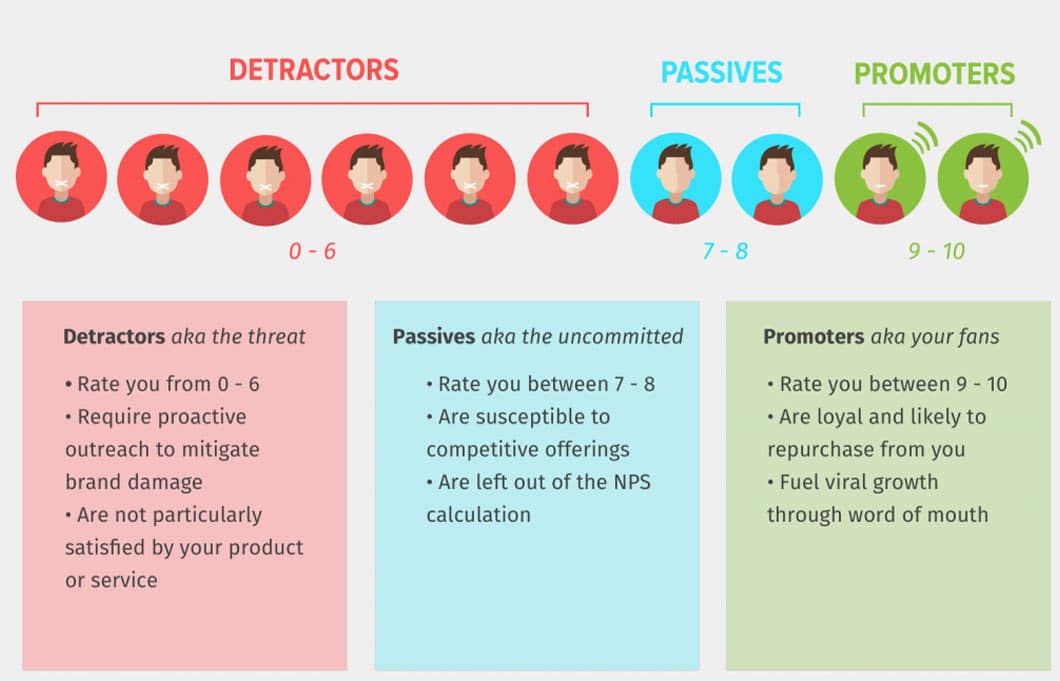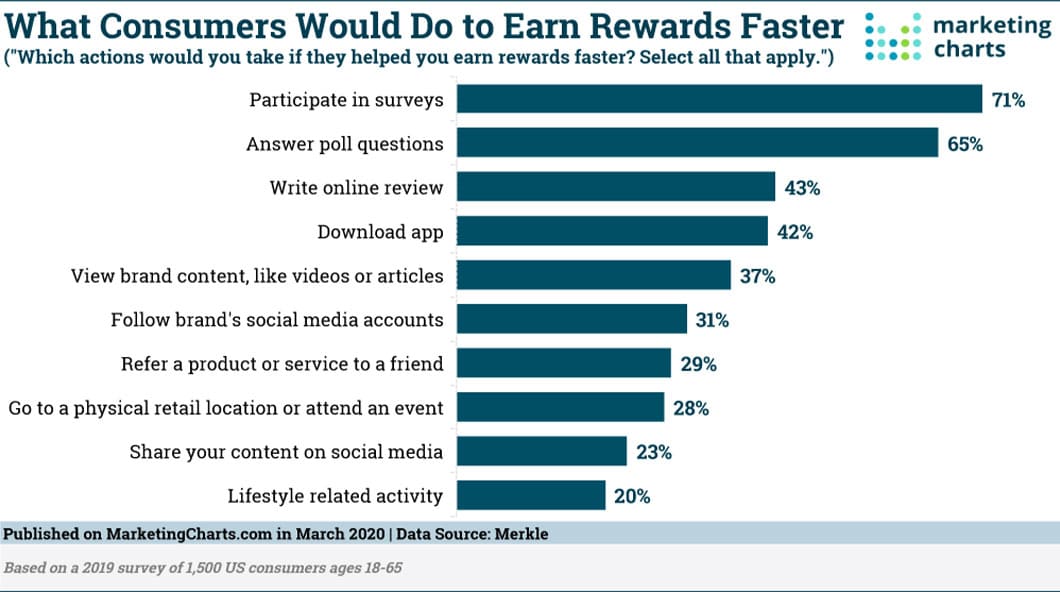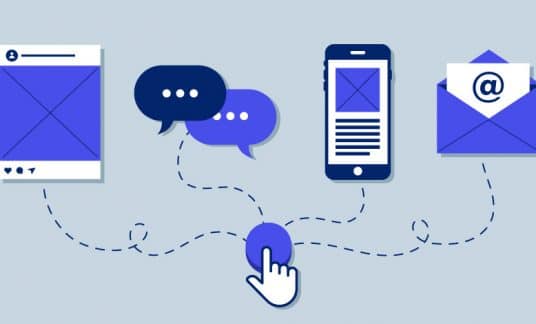Everyone knows happy customers are good, but do you know exactly how good they are for business?
Research by PwC found 43% of consumers would pay more for greater convenience and 42% of them would pay more for a friendly, welcoming experience. About 49% of customers have made an impulse purchase after receiving a personalized shopping experience.
Sounds like a gold mine, right? It can be, but how do you know what your customers would classify as a “great experience?”
It’s simple: Ask them.
Here are 5 ways you can use customer feedback surveys to grow sales, innovate new solutions and make better decisions backed up with data.
Customer Survey Basics: What to Include
These 5 components should be built into every customer survey you send out.
1. Net Promoter Score
A promoter is someone who rates your company as either a 9 or 10 out of 10 when asked if they would recommend you to others. A Net Promoter Score is calculated by taking the percentage of people who answer 9 or 10 (super happy customers) and subtracting those who answer 6 or below (neutral and unsatisfied customers).
A positive Net Promoter score means that overall, you have more satisfied customers than unsatisfied ones. This signals growth. A negative score means you need to do some serious work within your customer experience.
Make sure every survey has the question, “How likely are you to refer us to your friends and family?” with a multiple-choice selection from 1-10.

2. Personalization
Even small personalization tricks can have a big impact on your survey completion rates. Emails with personalized subject lines have a 50% higher open rate than standard ones, according to data from Yes Lifecycle Marketing.
It can be as simple as adding their first name into the subject line and body of the email.
But to really capitalize on personalization, you need to go deeper. Segmenting your email list into types of customers will give you richer data and allow you to customize your messaging to each group.
For example, create lists based on how many times they have ordered or how much they’ve spent with your company. To the group of high spenders, you can personalize the email to say how grateful you are for their business and let them know they’re one of your VIPs.
This personalization has an added benefit for you, too: Emails with personalized calls to action have a 202% higher conversion rate, according to HubSpot.
Even a small thing like a few thank-you lines in an email can go a long way toward making your most valuable customers feel seen and appreciated.
3. Design for Mobile First
About 62% of all emails are opened on mobile devices, according to Adestra. It’s not good enough to have mobile-optimized emails, they must be designed mobile first.
Assume everyone is going to open your email on mobile. Ensure text size is readable and clear and that buttons are large enough to comfortably click on.
Also keep in mind auto-dark mode features, such as how the iPhone switches app backgrounds to black at night. Ensure your email code isn’t overwriting these features.
4. Completion Reward
A surefire way to bolster your survey responses is to offer a reward for completing the survey. This could be a discount coupon or an entry into a prize draw. Customers will feel as though you value their time and be much more likely to fill it out.
If you have an existing rewards program, you could also offer points (or whatever your rewards system is based on) for completion.
According to research by Merkle, 71% of customers would be willing to complete surveys to earn rewards faster.

5. Structured Data
Structured data is important for quickly aggregating all the data that’s coming in.
Using structured data basically means avoiding the use of open-ended or text box answers and sticking to multiple choice or scale of 1-10 type answers. This way, everyone’s answers can be compared with each other and summarized.
Open-ended responses can give you valuable feedback, especially about certain features in software or an in-store experience. These types of detailed answers can show you the strengths and weaknesses in your company.
However, they make it difficult to create averages and benchmarks, which are essential for setting improvement targets and knowing at a glance where your company stands with customer happiness and loyalty.
By using a structured approach, you can easily turn millions of responses into actionable data, such as this survey example from McDonald’s with multiple-choice answers.

5 Ways to Improve Your Business with Customer Surveys
1. Feature Development
This is an obvious one but ask your customers about specific features. This is a good place to use structured data to have your customers rate certain features on a 1-10 scale of how much they use it, or like/dislike it.
You can also use a similar scale to see how interested they would be in new features on a scale from 1-10.
This is typically a software model but can apply to physical products as well. Ask users to rate attributes of your clothing brand, such as how stylish they think it is, comfortable, functional for workouts (for athletic wear, for example).

Your customers’ favorite features may surprise you. Maybe a feature you didn’t think was very important is the majority’s number 10 ranking: Their most important feature. This is valuable insight into not only what makes people buy your product, but what problems you help solve for them. When you know that, you can more effectively market and sell to customers like these.
2. Use Survey Data to Set and Measure Goals
Goals need to be built on data and customer surveys give you that data. But, goals also need to be measurable and attainable.
Sure, your ultimate goal may be 100% customer satisfaction but in the real world, there are bound to be a few people you can’t please.
Instead of setting your target at 100%, look where you’re currently at. If your customer survey data is showing an average of 75% of customers are happy, you could set a goal to make that 85% by next quarter. A 10% boost is measurable, and possible in 3 months time. You can track your progress weekly by looking at the most recent survey data coming in.
This also is more motivating for your team to have a concrete, achievable improvement to work towards and the data to support it.
3. Create Benchmarks
Similar to goal setting, you can also use survey responses to set company-wide benchmarks.
A few benchmark examples:
- Loyalty (% of customers who place more than 1 order)
- Satisfaction
- Order accuracy
- Shipping times
All of these can be turned into benchmarks based on survey results, as long as you’re using structured data to collect the information. (See how important structured data is?)
This is one of the most powerful ways customer surveys can help your business. Benchmarks ensure a consistent customer experience every time.
4. Create Something New
Customer surveys are also powerful tools for innovation.
Some of this may come from open-ended questions (e.g. unstructured data), but if you’re hearing the same complaints or feature requests repeatedly, it’s time to make a change. If it’s something that makes sense to add to a current offering, great. If not, create an entirely new product to fill this void for your customers.
Customer surveys let you know if there’s a market for a new idea or feature before you even create it. There’s nothing more powerful than that for business decision making.
Starbucks began offering almond milk in 2014 after noticing the popular request on many of its surveys and social listening tools. In the U.S., almond milk accounts for 60% of the entire non-dairy beverage market. But before jumping on a trend and looking for sales data afterward, Starbucks used real customer data to decide if expanding their drink offerings was the right move before ever investing a cent in the launch process.
5. Update Your Target Personas
Sure, updating paperwork and marketing collateral may not be the most exciting thing on this list, but it does impact your business in a big way.
You may think you know your target customer, but maybe you don’t. Or, maybe your target has shifted over the years. Use the demographic data from your customer surveys to compare against the customer personas you created in the, most likely, distant past. Are they still accurate? Relevant? Are your target personas really the customers buying your product?
Surveys give you the chance to update your marketing strategy to ensure all the campaigns you’re putting out are attracting the right audience. Customer surveys tell all, from basic demographics all the way up to why they buy from you and how they found you.
That’s marketing gold. Knowing you’re targeting the right people will save you thousands in otherwise potentially wasted ad spend (plus months of frustrated testing and tweaking).
Starting Implementing Customer Surveys Today
Customer surveys give you a clear picture of what your customers think about you now, and the tools needed to set and measure improvement goals for the future.
Customer surveys also are a tool to discover exactly what your customers want from you, or need you to do better on, so that you can make changes now to benefit your business for years to come. For everything from improving shipping times or costs, new features, or even entirely new products, your customer survey data is at the root of it all.
Start creating customer surveys now and know exactly where you stand — just don’t forget the structured data.











